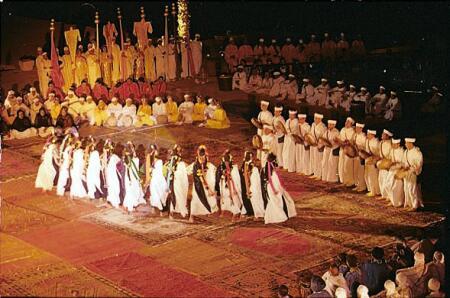Morocco is home to dozens of different traditional dances and musical styles rooted in Arab, Berber and African culture. Visitors can experience Moroccan dances by attending local weddings and parties, going to dance shows at hotels and restaurants, taking cultural tours or attending music and dance festivals.
Shikat
Shikat is the dance commonly known as Moroccan ‘belly dance’ or arabesque. Professional shikat dancers wear colorful costumes with tight, midriff-baring sequined tops and long loose skirts or pants. The dance is characterized by sensual hip movements, pelvic undulations and flowing hand movements. Often a hip scarf is worn to bring attention to the movements of the lower body. Belly dance music alternates between rhythmic percussion sections – which call for quick, sharp body movements – and fluid string sections that prompt more graceful, flowing movements.
If you attend a Moroccan wedding or party, the female guests will most likely be dancing shikat. Instead of belly dance costumes, the women wear traditional wedding clothing called kaftans. These outfits have long, bell-shaped sleeves, delicate embroidery and loose skirts. One woman may dance in the middle of a circle while other women stand around her clapping to the beat of the music. If men are present, the men may kneel down in a circle and encourage the woman to continue her solo dance.
Guedra
Guedra is a traditional dance of the Tuareg Berber from the Goulmime area in southern Morocco. The dance’s name comes from the name of a traditional cooking pot called the guedra that is used to provide the percussive beat of the dance. Only women take part in the dance, and they usually wear loose blue robes and festive head dresses decorated with cowrie shells.
To perform guedra, a group of women kneel in a circle. The group starts singing and clapping, and one woman moves into the middle to perform a solo. The soloist starts her dance covered in a veil that is gradually removed as she moves her hands and shoulders in sharp, quick movements. Much of her solo is performed while kneeling, although she may also stand up during the dance. As the dance intensifies, the women in the circle ululate with their tongues and sing more loudly. The dance ends when the solo dancer throws off the veil and collapses on her back.
Awash
Performed in the High Atlas Mountains and particularly in the Ouarzazate area, the awash dance takes place around a fire. The male participants sit in a circle playing wooden bendir drums, while the women stand motionless in a larger circle. As the rhythm of the drums increase the women start swaying with the beat.
Gnaoua
Gnaoua is a type of music with Sub-Saharan roots and both Arab and Berber influences. The Moroccan oboe, or ghaita, is played to a background of highly rhythmic percussion. Gnaoua dance is characterized by swaying motions, high jumping and acrobatic movements. It is usually performed by a group of men. Visitors to Morocco can see live gnaoua performances at the Marrakech Popular Arts Festival or the World Gnaoua Festival that take place every summer in Morocco.




















